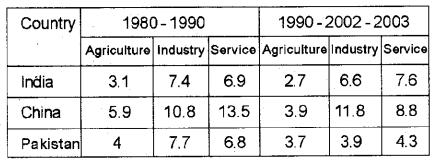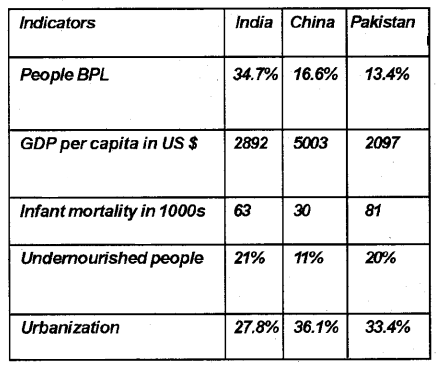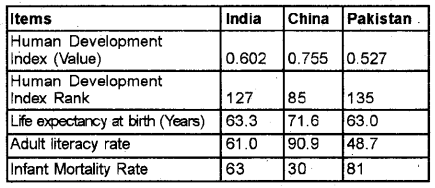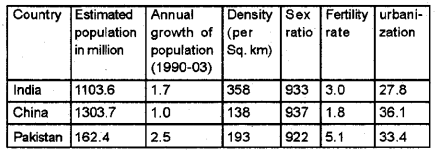Kerala Plus One Economics Chapter Wise Previous Questions Chapter 10 Comparative Development Experience of India with its Neighbours
Question 1.
Classify the following features pertaining to the economies of India and China. (March 2009)
Reforms were introduced in 1978.
Reforms were introduced in 1991.
Commune system, land reforms,
Adult literacy = 61%
Adult literacy = 90.9%
Answer:
India
- Land Reforms
- Reforms of 1991
- Adult Literacy 61%
China
- Reforms 1978
- Commune system
- Adult Literacy 90.9%
Question 2.
Pick the odd one out: (March 2009)
Great Leap Forward, One child norm, Growth due to the service sector, Proletarian cultural revolution.
Answer:
Growth due to the service sector. Others relate to Chinese development.
Question 3.
Policy measures adopted in India and China are almost similar. But the impact of these measures was different in these two economies. Compare the development experiences of these two economies. (Say 2009)
Answer:
Mention important policy measures of India and China.
China has the policy measures like – Great Leap Forward, Commune system, Special Economic Zones, Economic reforms of 1978, etc. India had policy measures like the Green Revolution, Economic Reforms, Special Economic Zones, etc.
Question 4.
The present-day fast industrial growth in China can be traced back to the reforms introduced in 1978. Substantiate. (March 2010)
Answer:
China’s rapid industrial growth can be traced back to its reforms in 1978. This is because reforms in agriculture and the establishment of infrastructure in the areas of education and health, land reforms, etc. had been taking place with the introduction of reforms. In the initial phase, reforms were initiated in agriculture, foreign trade, and investment sectors. In the later phase, reforms were initiated in the industrial sector. Private sector firms arid township and village enterprises were allowed to produce goods.
The reform process also involves dual pricing. It was found that the establishment of infrastructure in the areas of education and health, land reforms, the long existence of decentralized planning, and the existence of small enterprises had helped positively in improving the social and income indicators in the post-reform period. In short, it can be concluded that China’s rapid industrial growth can be traced back to its reforms in 1978.
Question 5.
Write the years of the following events: (March 2010)
| Events | Year | |
| A | Great leap forward | |
| B | The great Proletarian revolution | |
| C | First five year plan in India | |
| D | First five year plan in China | |
| E | First five year plan in Pakistan | |
| F | Structural reforms in China |
Answer:
- A – 1958
- B – 1965
- C – 1951
- D – 1953
- E – 1955
- F – 1978
Question 6.
Connect columns B and C with A. (March 2011)
| A | B | C |
| Industrial Policy resolution | Communes | 1991 |
| NABARD | Disinvestment | 1956 |
| Great leap forward | Licensing | 1982 |
| Privatisation | Rural credit | 1958 |
Answer:
| A | B | C |
| Industrial Policy resolution | Licensing | 1956 |
| NABARD | Rural credit | 1958 |
| Great leap forward | Communes | 1982 |
| Privatisation | Disinvestment | 1991 |
Question 7.
Discuss the salient demographic indicators of China, Pakistan, and India. (March 2011)
Answer:
| Indicators | India | China | Pakistan |
| Population | 1103.6 | 1303.7 | 162.4 |
| Population growth rate | 1.7 | 1 | 2.5 |
| Density | 358 | 138 | 193 |
| Sex ratio | 933 | 937 | 922 |
| Fertility rate | 3.0 | 1.8 | 5.1 |
Question 8.
The following table shows trends in the growth of output of different sectors of India, China, and Pakistan. Analyse the important trends. Trends in the growth of output in different sectors during 1980-2003. (March 2011)

Answer:
In India, the service sector showed positive growth while the agriculture and industrial sectors showed declining growth during 1980-2003.
In China, the Industrial sector showed positive growth while the agriculture and service sectors showed a decline in growth rate.
In Pakistan, all the 3 sectors showed a decline in growth rate during the period of analysis.
Question 9.
True or False.
In order to attract foreign investors, SEZ was set up in Pakistan. (March 2012)
Answer:
True
Question 10.
China is one of the fastest-growing economies in the world. Analyze some of the socio-economic indicators given in the table to see whether the economic growth has improved the socio-economic life of the Chinese people as compared to India and Pakistan. (March 2012)

Answer:
If we compare the indices given in the table, you will find that China is moving ahead of India and Pakistan. This is true for many indicators -income indicators such as GDP per capita, or proportion of population below the poverty line or health indicators such as mortality rates, access to sanitation, literacy, life expectancy, or malnourishment. Pakistan is ahead of India in reducing the proportion of people below the poverty line and also its performance in education, sanitation, and access to water is better than India. But neither of these two countries have been able to save women from maternal mortality.
In China, for one lakh births, only 50 women die whereas, in India and Pakistan, more than 500 women die. Surprisingly India and Pakistan are ahead of China in providing improved water sources. You will notice that for the proportion of people below the international poverty rate of $1 a day, both China and Pakistan are in similar positions whereas the proportion is almost two times higher for India. Find out for yourself how these differences occur.
In dealing with or making judgments on such questions, however, we should also note a problem with using the human development indicators given above with conviction. This occurs because these are all extremely important indicators, but these are not sufficient. Along with these, we also need what may be called ‘liberty indicators’. One such indicator has actually been added as a measure of the extent of democratic participation in social and political decision making tout it has not been given any extra weight.
Some obvious ‘liberty indicators’ like measures of the extent of Constitutional protection given to rights of citizens’ or the extent of constitutional protection of the Independence of the Judiciary and the Rule of Law’ have not even been introduced so far. Without including these (and perhaps some more) and giving them over-riding importance in the list, the construction of a human development index may be said to be incomplete and its usefulness limited.
Question 11.
Do you support the introduction of the one-child norm in India to control the population following the Chinese model? Give two arguments in support of your answer. (March 2012)
Answer:
Yes, I support the one-child norm,
1) it will reduce the pressure of population growth of the country.
2) it will solve the problem of food insufficiency in India.
Question 12.
China did not have any compulsion to introduce reforms. But China introduced structural reforms in 1978. Why? What were the effects of these reforms? (Say 2012)
Answer:
China’s rapid industrial growth can be traced back to its reforms in 1978. This is because reforms in agriculture and the establishment of infrastructure in the areas of education and health, land reforms, etc. had been taking place with the introduction of reforms.
In the initial phase, reforms were initiated in agriculture, foreign trade, and investment sectors. In the later phase, reforms were initiated in the industrial sector. Private sector firms arid township and village enterprises were allowed to produce goods.
The reform process also involves dual pricing. It was found that the establishment of infrastructure in the areas of education and health, land reforms, the long existence of decentralized planning, and the existence of small enterprises had helped positively in improving the social and income indicators in the post-reform period. In short, it can be concluded that China’s rapid industrial growth can be traced back to its reforms in 1978.
Question 13.
“Many developed countries were finding it difficult to maintain a growth rate of even 5%. China was able to maintain a near double-digit growth for more than two decades.”
Can you point out the main strategies adopted by China to attain this? (March 2013)
Answer:
India and Pakistan became independent nations in 1947, while the People’s Republic of China was established in1949.
The present-day fast industrial growth in China can be traced back to the reforms introduced in 1978. China introduced reforms in phases.
In the initial phase, reforms were initiated in agriculture, foreign trade, and investment sectors. In agriculture, for instance, commune lands were divided into small plots which were allocated (for use, not ownership) to individual households. They were allowed to keep all income from the land after paying stipulated taxes. In the later phase, reforms were initiated in the industrial sector.
Private sector firms, in general, and township and village enterprises, i.e. those enterprises which were owned and operated by local collectives, in particular, were allowed to produce goods. At this stage, enterprises owned by the government which we, in India, call public sector enterprises, were made to face competition. Their form process also involved dual pricing. This means fixing the prices in two ways; farmers and industrial units were required to buy and sell fixed quantities of inputs and outputs on the basis of prices fixed by the government and the rest were purchased and sold at market prices. Over the years, as production increased, the proportion of goods or inputs transacted in the market was also increased. In order to attract foreign investors, special economic zones were set up.
Question 14.
Compare the development path followed by India after independence with that of Pakistan and China. (Say 2013)
Answer:
Developmental Path – A Snapshot View
India and Pakistan became independent nations in 1947, while the People’s Republic of China was established in 1949.
All three countries had started planning their development strategies in similar ways. While India announced its first Five Year Plan for 951-56, Pakistan announced its first five-year plan, called, the Medium Term Plan, in 1956. China announced its First Five Year Plan in 1953. Till 1998, Pakistan had eight five year plans whereas China’s tenth five year period is 2001-06.
China: After the establishment of the People’s Republic of China under one-party rule, all the critical sectors of the economy, enterprises, and lands owned and operated by individuals were brought under government control.
The Great Leap Forward (GLF) campaign initiated in 1958 aimed at industrializing the country on a massive scale. People were encouraged to set up industries in their backyards. In rural areas, communes were started. Under the Commune system, people collectively cultivated lands. In1958, there were 26,000 communes covering almost all the farm population.
In 1965, Mao introduced the Great Proletarian Cultural Revolution (1966-76) under which students and professionals were sent to work and learn from the countryside.
Pakistan: While looking at various economic policies that Pakistan adopted, you will notice many similarities with India. Pakistan also follows the mixed economy model with the co-existence of public and private sectors. In the late 1950s and 1960s, Pakistan introduced a variety of regulated policy framework (for import substitution industrialization). The policy combined tariff protection for the manufacturing of consumer goods together with direct import controls on competing imports. The introduction of the Green Revolution led to mechanization and an increase in public investment in infrastructure in select areas, which finally led to a rise in the production of food grains.
During this period, Pakistan also received financial support from western nations and remittances from the continuously increasing outflow of emigrants to the Middle-east. This helped the country in stimulating economic growth. The then government also offered incentives to the private sector. All this created a conducive climate for new investments. In 1988, reforms were initiated in the country.
Question 15.
Which of the following countries have the highest adult literacy rate? (Say 2013)
a) China
b) Pakistan
c) India
d) China and India
Answer:
a) China
Question 16.
Group the following features pertaining to the economies of India, China, and Pakistan. (Say 2013)
(One-child norm, very high fertility rate, commune system, high density of population, economic reforms in 1988, economic reforms in 1991).
Answer:
Economy of India
- The high density of population
- Economic reforms in 1991
Economy of China
- One child norm
- Commune system
Economy of Pakistan
- Very high fertility rate
- Economic reforms in 1988
Question 17.
“China is moving ahead of India and Pakistan in many of the Human Development Indicators”. Prepare any four points to support the above argument. (Say 2014)
Answer:
The following table shows some of the salient features of China, India, and Pakistan with respect to human development indicators.

It can be found that the HDI index and value are much better in China compared to India and Pakistan. That is China is ahead of India and Pakistan on many human development indicators. Similarly, the life expectancy rate is higher in China compared to India and Pakistan. In India and Pakistan, the life expectancy rate is almost similar that is 63 years. The adult literacy rate is very high in China and the infant mortality rate is comparatively lower. Thus China has made a better development in respect of HDI compared to India and Pakistan.
Question 18.
In which country was the great leap forward cam¬paign initiated in 1958? (March 2015)
a) India
b) China
c) Russia
d) Pakistan
Answer:
b) China
Question 19.
Compare the development experience of India, China, and Pakistan with reference to demographic indicators, G.D.P., growth rate, and development strategies. (March 2015)
Answer:
Demographic Indicators
If we look at the global population, out of every six persons living in this world, one is an Indian and another Chinese. We shall compare some demographic indicators of India, China, and Pakistan. The population of Pakistan is very small and accounts for roughly about one-tenth of China or India. Though China is the largest nation among the three, its density is the lowest though geographically it occupies the largest area.

The table shows the population growth as being highest in Pakistan, followed by India and China. Scholars point out the one-child norm introduced in China in the late 1970s as the major reason for low population growth. They also state that this measure led to a decline in the sex ratio, the proportion of females per 1000 males. However, from the table, you will notice that the sex ratio is low and biased against females in all three countries. Scholars cite son preference prevailing in all these countries as the reason.
In recent times, all three countries are adopting various measures to improve the situation. The One-child norm and the resultant arrest in the growth of the population also have other implications. For instance, after a.few decades, in China, there will be more elderly people in proportion to young people. This will force China to take steps to provide social security measures with fewer workers. The fertility rate is also low in China and very high in Pakistan. Urbanization is high in both Pakistan and China with India having 28 percent of its people living in urban areas.
Indicators of Human Development
Let us look at how India, China, and Pakistan have performed in some of the select indicators of human development. If we compare the indices given in the Table, you will find that China is moving ahead of India and Pakistan.
This is true for many indicators – income indicators such as GDP per capita, or the proportion of the population below the poverty line, or health indicators such as mortality rates, access to sanitation, literacy, life expectancy, or malnourishment.
Pakistan is ahead of India in reducing the proportion of people below the poverty line and also its performance in education, sanitation, and access to water is better than India.
| Item | India | China | Pakistan |
| Human Development Index | 0.602 | 0.755 | 0.527 |
| Rank | 127 | M85 | 135 |
Question 20.
Fill in the blanks with the correct answers given in the bracket. (Say 2015)
(India, Pakistan, China)
- First five-year plan of _______ commenced in 1956.
- Maternal mortality rate is high in _________
- Proportion of people below poverty line is more in _________
- Reforms in _________ were introduced in 1978.
Answer:
- Pakistan
- India
- India
- China
Question 21.
Classify the following features pertaining to the economies of India, China, and Pakistan. (March 2016)
(One child norm, very high fertility ratio, commune system, high density of population, economic reforms in 1988, economic reforms in 1991).
Answer:
India
- High density of population
- Economic reforms in 1991
China
- One child norm
- Commune system
Pakistan
- Very high fertility rate
- Economic reforms in 1988
Question 22.
Compare and contrast the development experiences of India, China, and Pakistan with respect to development strategies and economic reforms. (Say 2016)
(Hint: Write any two points each).
Answer:
| India | China | Pakistan |
| Reforms introduced in 1991 | Reforms introduced in 1978 | Reforms introduced in 1988 |
| Democratic country | Lack of political freedom | Political instability |
| Urbanization low | Urbanization high | Urbanization high |
| Government & private sector | Govt sector | Govt & private sector |
Question 23.
State to which country the following demographic features belong to. (March 2017)
(Hint: India, China, or Pakistan)
- Highest annual growth of population
- Lowest population density
- Less urbanization
- High fertility rate
Answer:
- Highest annual growth of population – Pakistan
- Lowest population density – China
- Less urbanization – India
- High fertility rate – Pakistan
